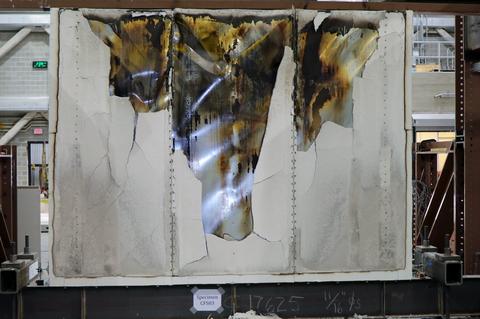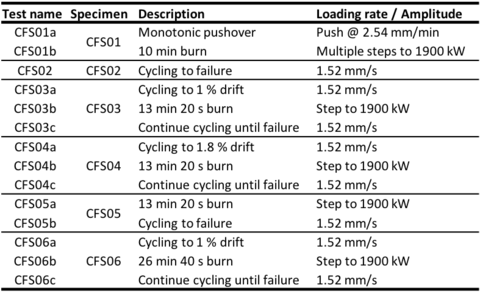Shear Walls Fire (Phase 1)

This study experimentally investigates multi-hazard (earthquake & fire) interaction for steel-sheathed cold-formed steel (CFS) framed shear walls. These lateral load-resisting systems are widely used in seismic regions in the western United States.
Six 2.7 m by 3.7 m shear wall specimens were fabricated consisting of 150 mm wide CFS framing sheathed on one side with sheet steel adhered to Type X gypsum board and on the opposite side with Type X gypsum board. The specimens were subjected sequentially to varied combinations of mechanical (shear) deformation and thermal (fire) loading. Specimen 1 (CFS01) was used to establish the monotonic “pushover” load-displacement capacity of the wall system and subsequently to shake down the fire test setup. Specimen 2 (CFS02) was loaded by symmetric-amplitude reverse-cyclic shear deformation to destruction (defined here as 2.8% drift ratio) to establish the cyclic load-displacement response. Specimen 3 and 4 (CFS03 and CFS04) were cycled to deformations just before and after the peak load was achieved, respectively, burned for 13 min and 20 s and then cycling was continued until destruction of the wall. For Specimen 5 (CFS05), an undamaged wall was exposed to fire for 13 min and 20 s and then cycled to destruction. Specimen 6 (CFS06) was tested similarly to Specimen 3, however, the burn duration was doubled. Details about the specimens and test setup are provided in publications cited below.
The NIST experiments were based on and used to inform investigations of a six-story, cold-formed steel framed building conducted by researchers from the University of California, San Diego (UCSD) and Worcester Polytechnic Institute (WPI) in San Diego in June of 2016. The aim was to study the earthquake performance of this construction method for mid-rise structures (five to ten stories), as well as the earthquake-damaged building's response to fire. For information about the tests at UCSD, please visit the project website.
DATA

The following spreadsheets (click links to download) include the final scaled data from the experiments. Information about the sensor types, locations, naming and uncertainties can be found in the Report of Test cited below.
- CFS01 (CFS01a, CFS01b)
- CFS02 (CFS02)
- CFS03 (CFS03a, CFS03b,CFS03c)
- CFS04 (CFS04a, CFS04b,CFS04c)
- CFS05 (CFS05a, CFS05b)
- CFS06 (CFS06a, CFS06b,CFS06c)
VIDEO GALLERY
RELATED PUBLICATIONS
- Hoehler, M. S.; Smith, C. M.: Influence of Fire on the Lateral Load Capacity of Steel-sheathed Cold-Formed Steel Shear Walls - Report of Test, NIST Interagency/Internal Report (NISTIR) – 8160, 2016, pp 65.
- Hoehler, M. S.; Smith, C. M.; Hutchinson, T. C.; Wang, X.; Meacham, B. J.; Kamath, P.: “Behavior of steel-sheathed shear walls subjected to seismic and fire loads.” Fire Safety Journal, Volume 91, 2017, Pages 524-531, https://dx.doi.org/10.1016/j.firesaf.2017.03.021.
- Wang, X., Hutchinson, T.C., Hegemier, G., Gunisetty, S., Kamath, P, and Meacham, B. (2018). Earthquake and fire performance of a mid-rise cold-formed steel framed building – test program and test results: Final Report, SSRP-2018/16, Dept. of Structural Engineering, Univ. of California, San Diego, La Jolla, CA.
Contacts
-
(301) 975-8517

